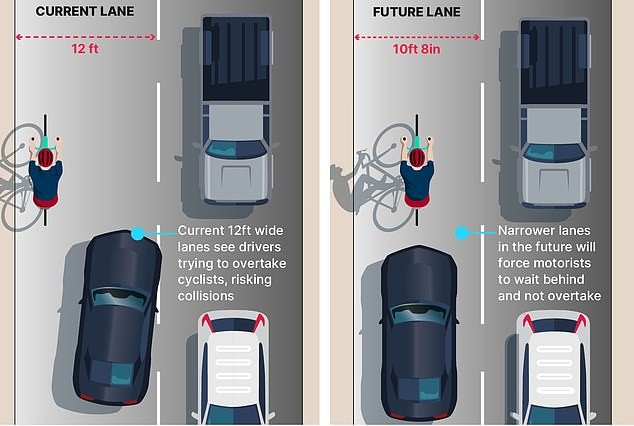Britain Narrows Its Lanes to Stop Overtaking Cyclists as Government War on Motorists Deepens
Road lanes across the country are to become narrower to stop cars overtaking cyclists as part of a new war on motorists, The Mail on Sunday can reveal.

In This Article:
Lane widths shrink to about 3.25–3.91 meters on local roads
Official guidance quietly published last week on the Government's website states that the standard width of a road lane in Britain – about 3.66 meters – is no longer appropriate because of the safety risk posed to cyclists.\n\nInstead, lanes on local roads should either shrink to about 3.25 meters or expand to at least about 3.91 meters. Narrower roads, the guidance says, would make it clearer to motorists 'there is not enough space to safely overtake cyclists', while also showing cyclists 'that they need to ride more centrally'.\n\nThe guidance, which was drawn up by Active Travel England (ATE), a Government agency, will be applied to billions of pounds of future road building schemes, the MoS has learnt. Local authorities which defy the recommendations could see reduced transport funding.

ATE’s role and the financial stakes for councils
Under the new plans, lanes on local roads should either shrink to about 3.25 meters or expand to at least about 3.91 meters. The guidance, drawn up by Active Travel England (ATE) and led by former Olympic cyclist Chris Boardman, frames the change as a safety measure to curb dangerous overtaking.\n\nATE, a Government agency, will be applied to billions of pounds of future road building schemes, the MoS has learnt. Local authorities which defy the recommendations could see reduced transport funding.\n\nATE, which is led by former Olympic cyclist Chris Boardman, says motorists using a standard 3.66-meter-wide traffic lane 'may try to overtake cyclists when there is not enough space', increasing the risk of collisions. The guidance also states that lanes wider than 3.91 meters reduce the risk but 'may still not be wide enough for motor vehicles to safely overtake cyclists', while lanes that are narrower than 3.25 meters make it obvious to drivers that they must be patient and not overtake.\n\nThe guidance states: '...it is recommended that lanes between 3.25m (10ft 8in) and 3.9m (12ft 10in) are avoided.'

Reactions from motoring campaigners and cyclists
The move has angered motoring campaigners, who predict that it will dramatically worsen traffic jams on already clogged roads and provoke more conflict between drivers and cyclists.\n\nBrian Gregory, policy director at the Alliance of British Drivers, said: 'If you slow everybody down to the speed of cycles on narrow roads that is a huge economic cost to the country in wasted time.\nThe whole idea is just to make driving unpleasant instead of trying to get everybody to co-operate and work together to use roads safely. It's all about penalising motorists. It's completely stupid.'\n\nHoward Cox, founder of FairFuelUK, said: 'Narrowing our increasingly congested roads for the benefit of a small economic minority of road users makes no commercial or social sense.\n'It will lead to even more congestion, frustration and anger and be a detriment to small businesses and the high street. Active Travel England and the DfT should focus on ensuring cyclists use roads more sensibly, and stop hitting motorists at every opportunity.'\n\nEdmund King, AA president and a cyclist, said: 'It is impossible and impractical to change the widths of all our roads, which have evolved since Roman times.\nThis is not America where wider modern highways and more space means it would be possible to radically change road layouts. UK roads will always require a degree of give and take which can't just be ironed out by regulations.'

Official response from the Department for Transport
The Department for Transport said claims that ATE is waging a war on motorists 'are false and misrepresent the guidance'.\n\nThere has never been legally binding standards for road widths and that remains the case.\n\n'The Government is absolutely on the side of drivers. Over the past year alone, we invested an extra £500 million to help local authorities maintain their road networks, committed £1 billion to repair bridges, flyovers and tunnels, and gave the green light to over 30 road schemes to improve journeys across the country.'

